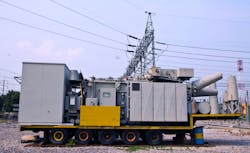Saft Provides Backup Power for Mobile Substations in Brazil
Saft’s Tel.X nickel batteries are providing critical backup power for nine mobile substations deployed by Copel, the Brazilian power and telecoms utility.
Copel is using the mobile substations to maintain continuity of supply during maintenance of critical substations on its network of 400 substations and 2,500 kilometers lines in Brazil’s southern Paraná region.
Power systems company Provolt selected the Tel.X nickel batteries as they are smaller than comparable Valve-Regulated Lead-Acid (VRLA) batteries, making them suitable for the tight envelope of space available.
Provolt has integrated them into battery systems to install in mobile substations alongside equipment such as switchgear, transformers, protection and control cabinets.
Nikolas Dreher from Provolt said, “Mobile substations need to provide the same level of performance as permanent substations from the back of a truck, where space and weight-carrying capacity are extremely limited. Battery systems based on Saft’s Tel.X cells gave us the right voltage and backup duration in a very small package, making them ideal for the job.”
In the case of an outage, the nickel battery systems will provide power to clear faults by reconfiguring switchgear and provide constant power for control and communications equipment.
Provolt ordered a total of nine battery systems, each of which is rated at 125 volts and stores up to 80 amp-hours energy.
The Tel.X nickel batteries manufactured in Valdosta, have a small size as they are usually installed at telecoms sites, where space is tight, and reliability is crucial.
